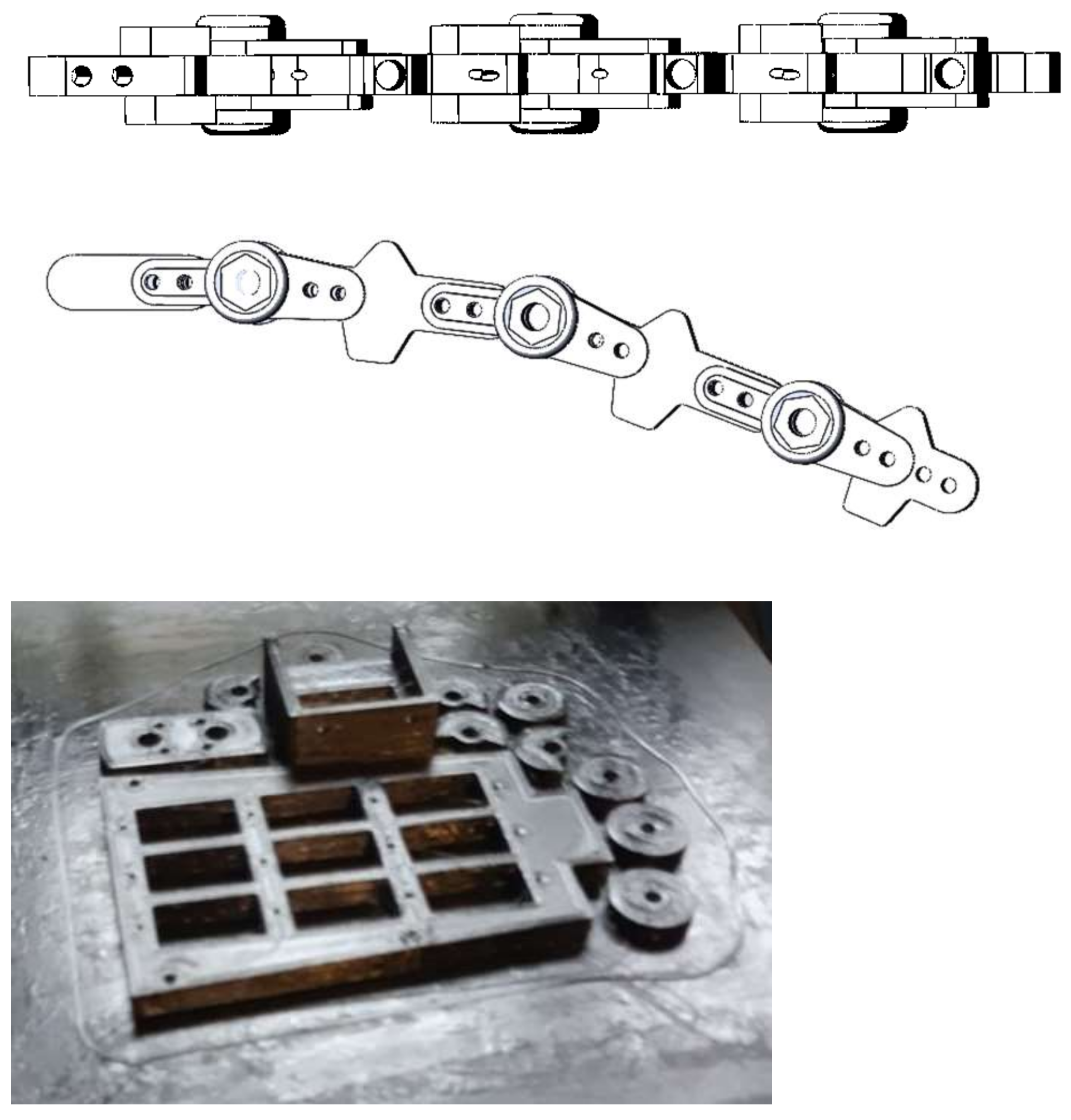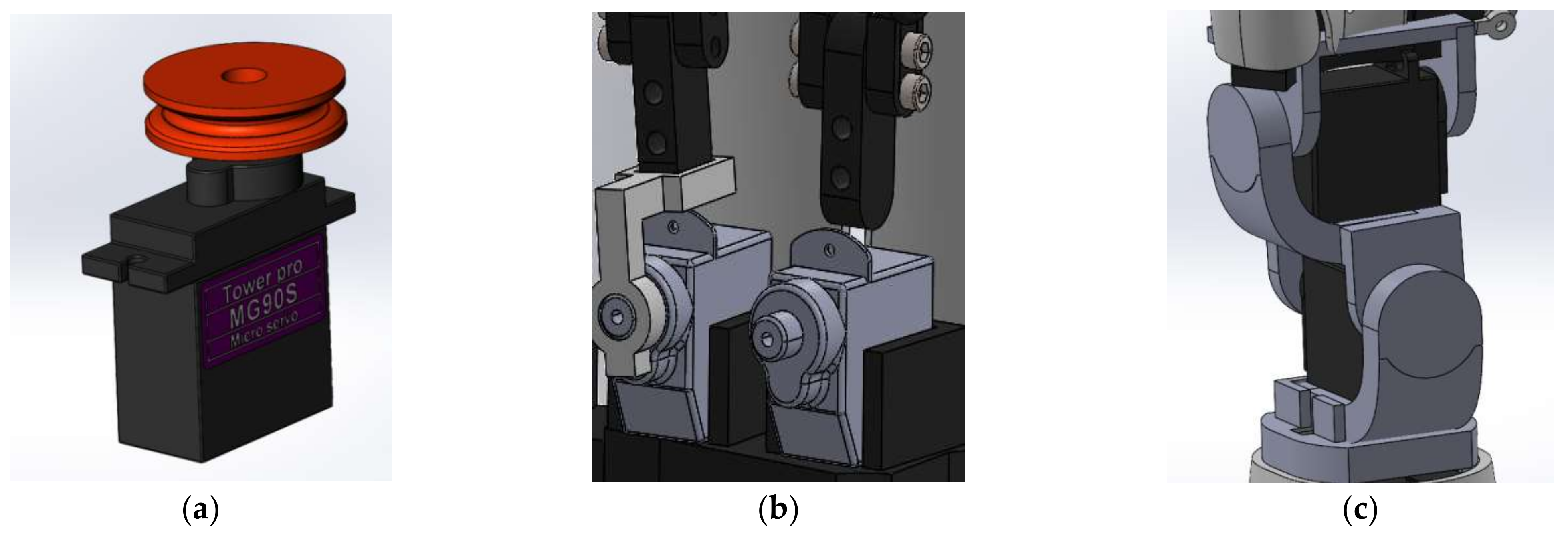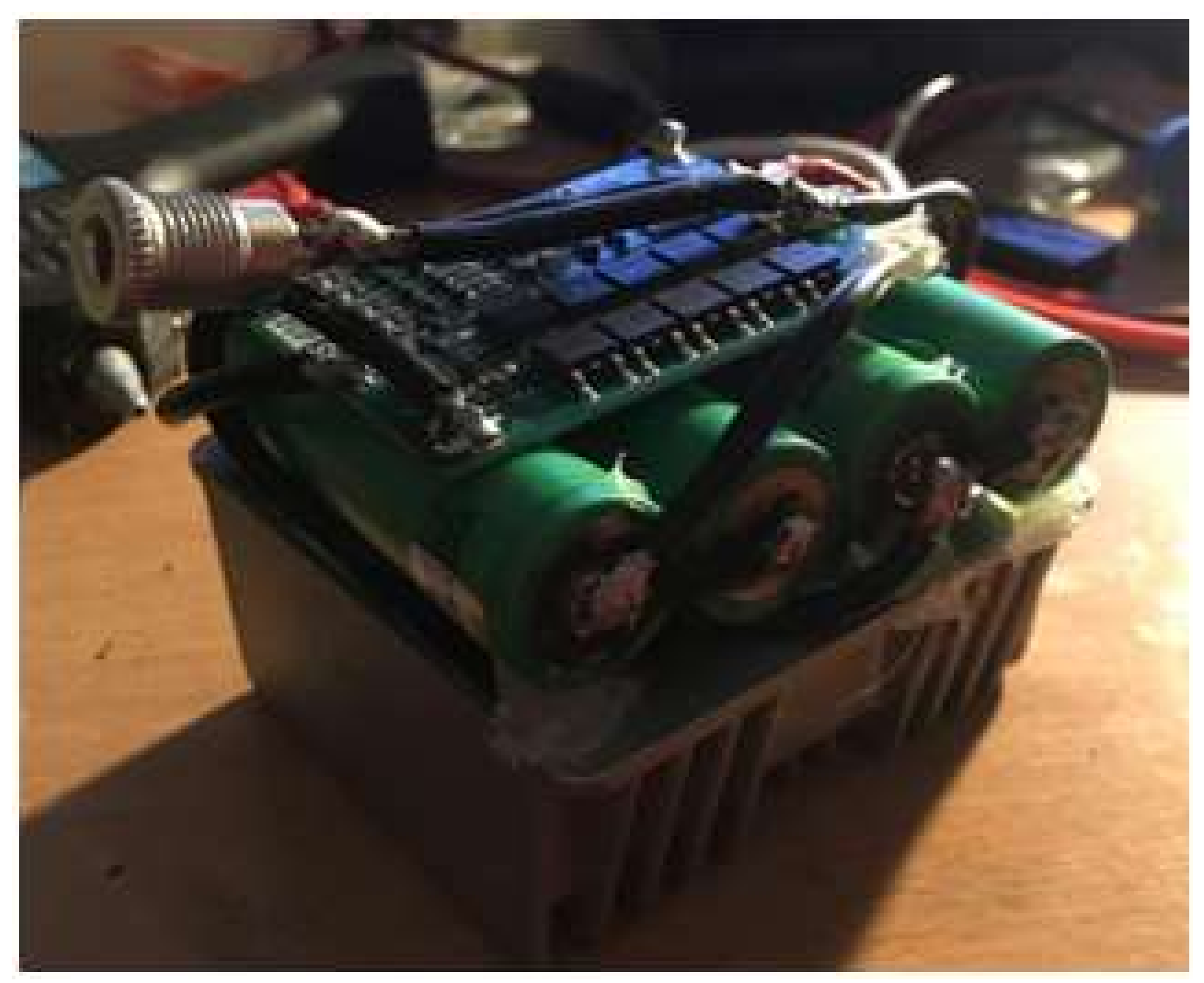Design and Implementation of an Anthropomorphic Robotic Arm Prosthesis
Abstract
:1. Introduction
- Analyzing the basic requirements for the parameters of an anthropomorphic robotic arm;
- Designing and developing the anthropomorphic robotic arm and manufacturing and assembling the mechanical parts for construction;
- The calculation, design and development of the power supply circuits and the control system of the anthropomorphic robotic arm were carried out to ensure the simultaneous control of all drives;
- Testing the possibilities of connecting to different control systems.
2. Related Works
3. Methods
3.1. Prototype Design and Manufacture
3.2. Control System
4. Results and Discussion
5. Conclusions
Author Contributions
Funding
Institutional Review Board Statement
Informed Consent Statement
Data Availability Statement
Conflicts of Interest
References
- Lee, S.U.; Choi, Y.S.; Jeong, K.M.; Jung, S. Development of an underwater manipulator for maintaining nuclear power reactor. In Proceedings of the 2007 International Conference on Control, Automation and Systems, Seoul, Korea, 17–20 October 2007; pp. 1006–1010. [Google Scholar] [CrossRef]
- Marinceu, D.; Murchison, A.; Hatton, C. Use of robotic equipment in a Canadian Used Nuclear Fuel Packing Plant. In Proceedings of the 2012 2nd International Conference on Applied Robotics for the Power Industry (CARPI), Zurich, Switzerland, 11–13 September 2012; pp. 139–144. [Google Scholar] [CrossRef]
- Bae, H.Y.; Jae-Paeng, I.; Kim, S.; Park, S.Y.; Shin, H.S.; Kim, D.B.; Han, S.H. A Robust Control of Robotic Hand with Nine Axis for Assembly and Handling of Parts in Forging Manufacturing Process. In Proceedings of the 2018 International Conference on Information and Communication Technology Robotics (ICT-ROBOT), Busan, Korea, 6–8 September 2018; pp. 1–3. [Google Scholar] [CrossRef]
- Park, C.; Kyung, J.H.; Choi, T.Y.; Do, H.M.; Kim, B.I.; Lee, S.H. Design of an industrial dual arm robot manipulator for a Human-Robot hybrid manufacturing. In Proceedings of the 2012 9th International Conference on Ubiquitous Robots and Ambient Intelligence (URAI), Daejeon, Korea, 26–28 November 2012; pp. 616–618. [Google Scholar] [CrossRef]
- Zhang, J.; Wang, W.; Cai, Y.; Li, J.; Zeng, Y.; Chen, L.; Yuan, F.; Ji, Z.; Wang, Y.; Wyrwa, J. A Novel Single-Arm Stapling Robot for Oral and Maxillofacial Surgery—Design and Verification. IEEE Robot. Autom. Lett. 2022, 7, 1348–1355. [Google Scholar] [CrossRef]
- Tavakoli, M.; Enes, B.; Santos, J.; Marques, L.; de Almeida, A.T. Underactuated anthropomorphic hands: Actuation strategies for a better functionality. Robot. Auton. Syst. 2015, 74, 267–282. [Google Scholar] [CrossRef]
- Nurpeissova, A.; Tursynbekov, T.; Shintemirov, A. An Open-Source Mechanical Design of ALARIS Hand: A 6-DOF Anthropomorphic Robotic Hand. In Proceedings of the 2021 IEEE International Conference on Robotics and Automation (ICRA), Xi’an, China, 30 May–5 June 2021; pp. 1177–1183. [Google Scholar] [CrossRef]
- Sanchez-Velasco, L.E.; Arias-Montiel, M.; Enrique Guzmán-Ramírez, E.; Lugo-González, E. A Low-Cost EMG-Controlled Anthropomorphic Robotic Hand for Power and Precision Grasp. Biocybern. Biomed. Eng. 2020, 40, 221–237. [Google Scholar] [CrossRef]
- Light, C.M.; Chappell, P.H. Development of a lightweight and adaptable multiple-axis hand prosthesis. Med. Eng. Phys. 2000, 22, 679–684. [Google Scholar] [CrossRef]
- Plagenhoef, S.; Evans, F.G.; Abdelnour, T. Anatomical Data for Analyzing Human Motion. Res. Q. Exerc. Sport 1983, 54, 169–178. [Google Scholar] [CrossRef]
- ten Kate, J.; Smit, G.; Breedveld, P. 3D-printed upper limb prostheses: A review. Disabil. Rehabil. Assist. Technol. 2017, 12, 300–314. [Google Scholar] [CrossRef] [PubMed]
- He, Z.; Yurievich, R.R.; Shimizu, S.; Fukuda, M.; Kang, Y.; Shin, D. A Design of Anthropomorphic Hand based on Human Finger Anatomy. In Proceedings of the 2020 International Symposium on Community-centric Systems (CcS), Tokyo, Japan, 23–26 September 2020; pp. 1–5. [Google Scholar] [CrossRef]
- Atasoy, A.; Toptaş, E.; Kuchimov, S.; Gulfize, S.; Turpçu, M.; Kaplanoglu, E.; Güçlü, B.; Özkan, M. Biomechanical Design of an Anthropomorphic Prosthetic Hand. In Proceedings of the 2018 7th IEEE International Conference on Biomedical Robotics and Biomechatronics (Biorob), Enschede, The Netherlands, 26–29 August 2018; pp. 732–736. [Google Scholar] [CrossRef]
- Devaraja, R.R.; Maskeliūnas, R.; Damaševičius, R. Design and Evaluation of Anthropomorphic Robotic Hand for Object Grasping and Shape Recognition. Computers 2021, 10, 1. [Google Scholar] [CrossRef]
- Estay, D.; Basoalto, A.; Ardila-Rey, J.; Cerda, M.; Barraza, R. Development and Implementation of an Anthropomorphic Underactuated Prosthesis with Adaptive Grip. Machines 2021, 9, 209. [Google Scholar] [CrossRef]
- Fajardo, J.; Ferman, V.; Cardona, D.; Maldonado, G.; Lemus, A.; Rohmer, E. Galileo Hand: An Anthropomorphic and Affordable Upper-Limb Prosthesis. IEEE Access 2020, 8, 81365–81377. [Google Scholar] [CrossRef]
- Kashef, S.R.; Amini, S.; Akbarzadeh, A. Robotic hand: A review on linkage-driven finger mechanisms of prosthetic hands and evaluation of the performance criteria. Mech. Mach. Theory 2020, 145, 103677. [Google Scholar] [CrossRef]
- Laffranchi, M.; Boccardo, N.; Traverso, S.; Lombardi, L.; Canepa, M.; Lince, A.; Semprini, M.; Saglia, J.A.; Naceri, A.; Sacchetti, R.; et al. The Hannes hand prosthesis replicates the key biological properties of the human hand. Sci. Robot. 2020, 5, 46. [Google Scholar] [CrossRef] [PubMed]
- Leddy, M.T.; Dollar, A.M. Preliminary Design and Evaluation of a Single-Actuator Anthropomorphic Prosthetic Hand with Multiple Distinct Grasp Types. In Proceedings of the 2018 7th IEEE International Conference on Biomedical Robotics and Biomechatronics (Biorob), Enschede, The Netherlands, 26–29 August 2018; pp. 1062–1069. [Google Scholar] [CrossRef]
- Owen, M.; Au, C.; Fowke, A. Development of a Dexterous Prosthetic Hand. J. Comput. Inf. Sci. Eng. 2018, 18, 010801. [Google Scholar] [CrossRef]
- Baspinar, U.; Barol, H.S.; Senyurek, V.Y. Performance Comparison of Artificial Neural Network and Gaussian Mixture Model in Classifying Hand Motions by Using sEMG Signals. Biocybern. Biomed. Eng. 2013, 33, 33–45. [Google Scholar] [CrossRef]
- Barabulut, D.; Ortes, F.; Arslan, Y.Z.; Adli, M.A. Comparative evaluation of EMG signal features for myoelectric controlled human arm prosthetics. Biocybern. Biomed. Eng. 2017, 37, 326–335. [Google Scholar] [CrossRef]
- Hakonen, M.; Piitulainen, H.; Visala, A. Current state of digital signal processing in myoelectric interfaces and related applications. Biomed. Signal Processing Control 2015, 18, 334–359. [Google Scholar] [CrossRef]
- Mott, R.L.; Vavrek, E.M.; Wang, J. Machine Elements in Mechanical Design; Pearson: New York, NY, USA, 2018. [Google Scholar]
- Grebenstein, M.; Albu-Schäffer, A.; Bahls, T.; Chalon, M.; Eiberger, O.; Friedl, W.; Gruber, R.; Haddadin, S.; Hagn, U.; Haslinger, R.; et al. The DLR Hand Arm System. In Proceedings of the 2011 IEEE International Conference on Robotics and Automation (ICRA), Shanghai, China, 9–13 May 2011; pp. 3175–3182. [Google Scholar] [CrossRef]
- Grebenstein, M.; van der Smagt, P. Antagonism for a Highly Anthropomorphic Hand–Arm System. Adv. Robot. 2008, 22, 39–55. [Google Scholar] [CrossRef]
- Ben-Tzvi, P.; Zhou, M.A. Sensing and Force-Feedback Exoskeleton (SAFE) Robotic Glove. IEEE Trans. Neural Syst. Rehabil. Eng. 2015, 23, 992–1002. [Google Scholar] [CrossRef] [PubMed]
- Abougarair, A.J.; Shashoa, N.A.A.; Elmelhi, A.M.; Gnan, H.M. Real Time Classification for Robotic Arm Control Based Electromyographic Signal. In Proceedings of the 2022 IEEE 2nd International Maghreb Meeting of the Conference on Sciences and Techniques of Automatic Control and Computer Engineering (MI-STA), Sabratha, Libya, 23–25 May 2022; pp. 155–160. [Google Scholar] [CrossRef]
- Controzzi, M.; Clemente, F.; Barone, D.; Ghionzoli, A.; Cipriani, C. The SSSA-MyHand: A dexterous lightweight myoelectric hand prosthesis. IEEE Trans. Neural Syst. Rehabil. Eng. 2017, 25, 459–468. [Google Scholar] [CrossRef] [PubMed]
- Young, M.J.; Lin, D.J.; Hochberg, L.R. Brain-Computer Interfaces in Neurorecovery and Neurorehabilitation. Semin. Neurol. 2021, 41, 206–216. [Google Scholar] [CrossRef] [PubMed]
- Mullin, E.; This Man Set the Record for Wearing a Brain-Computer Interface. Wired 2022. Available online: https://www.wired.com/story/this-man-set-the-record-for-wearing-a-brain-computer-interface/ (accessed on 1 September 2022).
- Robohand. Hand and Forearm Prototype. YouTube. Available online: https://www.youtube.com/watch?v=PXw_nXA1t0c (accessed on 30 July 2022).
- Motion Capture Glove Frame. YouTube. Available online: https://www.youtube.com/watch?v=tT_MFeVPESs (accessed on 30 July 2022).
- Motorica Manifesto Hand. BionicsForEveryone.Com. Available online: https://bionicsforeveryone.com/motorica-manifesto-hand/#grip-patterns-control (accessed on 30 July 2022).
- 8E70—bebionic Hand EQD. Ottobock. Available online: https://www.ottobock.com/en-us/product/8E70 (accessed on 30 July 2022).









| Project | DoF | Number of Actuators |
|---|---|---|
| Anthropomorphic robotic arm | 22 | 17 |
| Robotic arm [12] | 20 | 6 |
| Robotic arm [13] | 20 | 5 |
| Robotic arm [14] | 18 | 5 |
| Robotic arm [15] | 15 | 3 |
| Galileo Hand [16] | 15 | 6 |
| Robotic arm [8] | 11 | 6 |
| Hannes hand [18] | 9 | 1 |
| MyoAdapt Hand [19] | 10 | 6 |
| ALARIS hand [7] | 6 | 6 |
| Robotic arm [20] | 10 | 7 |
| Project | Anthropomorphic Robotic Arm | Bebionic 3 (England) | Motorica Manifesto Hand (RF) |
|---|---|---|---|
| Mass, of the arm part kg | 0.520 | 0.698 | 0.482 |
| maximum static weight, kg | 12 | 45 | 20 |
| battery options, mAh | 3000 | 2200 | 1200…3500 |
| degree of freedom (DoF) | 25 | 6 | 6 |
| Parameter | The Required Time to Perform the Flexion/Extension, ms | Finger Angles of Full Compression | Finger Angles of Full Extension | Proximal Phalanx | Distal Phalanx |
|---|---|---|---|---|---|
| Little finger | 0.1 | 89° | 90° | 90° | 83° |
| Ring finger | 0.1 | 89° | 90° | 90° | 82° |
| Middle finger | 0.1 | 89° | 90° | 90° | 82° |
| Index finger | 0.1 | 89° | 90° | 90° | 82° |
| Wrist rotation | 0.12 | - | - | - | - |
Publisher’s Note: MDPI stays neutral with regard to jurisdictional claims in published maps and institutional affiliations. |
© 2022 by the authors. Licensee MDPI, Basel, Switzerland. This article is an open access article distributed under the terms and conditions of the Creative Commons Attribution (CC BY) license (https://creativecommons.org/licenses/by/4.0/).
Share and Cite
Yurova, V.A.; Velikoborets, G.; Vladyko, A. Design and Implementation of an Anthropomorphic Robotic Arm Prosthesis. Technologies 2022, 10, 103. https://doi.org/10.3390/technologies10050103
Yurova VA, Velikoborets G, Vladyko A. Design and Implementation of an Anthropomorphic Robotic Arm Prosthesis. Technologies. 2022; 10(5):103. https://doi.org/10.3390/technologies10050103
Chicago/Turabian StyleYurova, Valentina A., Gleb Velikoborets, and Andrei Vladyko. 2022. "Design and Implementation of an Anthropomorphic Robotic Arm Prosthesis" Technologies 10, no. 5: 103. https://doi.org/10.3390/technologies10050103
APA StyleYurova, V. A., Velikoborets, G., & Vladyko, A. (2022). Design and Implementation of an Anthropomorphic Robotic Arm Prosthesis. Technologies, 10(5), 103. https://doi.org/10.3390/technologies10050103









